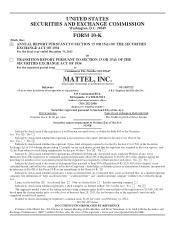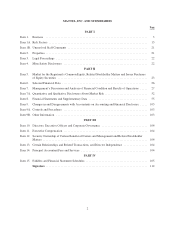Mattel 2013 Annual Report Download - page 14
Download and view the complete annual report
Please find page 14 of the 2013 Mattel annual report below. You can navigate through the pages in the report by either clicking on the pages listed below, or by using the keyword search tool below to find specific information within the annual report.products. To provide greater flexibility in the manufacture and delivery of its products, and as part of a
continuing effort to reduce manufacturing costs, Mattel has concentrated production of most of its core products
in company-owned facilities and generally uses third-party manufacturers for the production of non-core
products.
Mattel’s principal manufacturing facilities are located in China, Indonesia, Malaysia, Mexico, and Thailand.
To help avoid disruption of its product supply due to political instability, civil unrest, economic instability,
changes in government policies or regulations, and other risks, Mattel produces its products in multiple facilities
across multiple countries. Mattel believes that the existing production capacity at its own and its third-party
manufacturers’ facilities is sufficient to handle expected volume in the foreseeable future. See Item 1A
“Risk Factors.”
Mattel bases its production schedules for toy products on customer orders and forecasts, taking into account
historical trends, results of market research, and current market information. Actual shipments of products
ordered and order cancellation rates are affected by consumer acceptance of product lines, strength of competing
products, marketing strategies of retailers, changes in buying patterns of both retailers and consumers, and
overall economic conditions. Unexpected changes in these factors could result in a lack of product availability or
excess inventory in a particular product line.
The majority of Mattel’s raw materials are available from numerous suppliers but may be subject to
fluctuations in price.
Competition and Industry Background
Competition in the manufacture, marketing, and sale of toys is based primarily on quality, play value, and
price. Mattel offers a diverse range of products for children of all ages and families that include, among others,
toys for infants and preschoolers, girls’ toys, boys’ toys, youth electronics, hand-held and other games, puzzles,
educational toys, media-driven products, and fashion-related toys. The North America segment competes with
several large toy companies, including Bandai, Hasbro, Jakks Pacific, Leap Frog, Lego, MGA Entertainment,
Spin Master, Tomy, and VTech, many smaller toy companies, and several manufacturers of video games and
consumer electronics. The International segment competes with global toy companies including Bandai, Hasbro,
Lego, MGA Entertainment, Playmobil, Tomy, and VTech, other national and regional toy companies, and
manufacturers of video games and consumer electronics. Foreign regions may include competitors that are strong
in a particular toy line or geographical area but do not compete with Mattel or other international toy companies
worldwide. The American Girl segment competes with companies that manufacture girls’ toys and with
children’s book publishers and retailers.
Competition among the above companies is intensifying due to recent trends towards shorter life cycles for
individual toy products and an increasing use of high technology in toys. In addition, as a result of the
phenomenon of “children getting older younger” resulting from children outgrowing toys at younger ages, Mattel
competes with companies that sell products outside the toy aisle, such as electronic consumer products and video
games. Competition continues to be heavily influenced by the fact that a small number of retailers account for a
large portion of all toy sales, allocate the shelf space from which toys are viewed, and have direct contact with
parents and children through in-store purchases, coupons, and print advertisements. Such retailers can and do
promote their own private-label toys, facilitate the sale of competitors’ toys, and allocate shelf space to one type
of toy over another. Competition is also intensifying due to the availability of online-only distributors, including
Amazon.com, which are able to promote a wide variety of toys and represent a wide variety of toy
manufacturers, and with limited overhead, do so at a lower cost.
Seasonality
Mattel’s business is highly seasonal, with consumers making a large percentage of all toy purchases during
the traditional holiday season. A significant portion of Mattel’s customers’ purchasing occurs in the third and
6
























